Alert Log
Fetches an amount of entries from the alert action log of a host group. These results are selected based on a specific severity of triggers and displayed in a list.
Users with the necessary permissions can access all widget types while creating a template. However, data that is then retrieved by each widget from the Zabbix server depends on the Zabbix permissions of the service user.
Widgets can be configured within the template, or on report-level.
To configure a widget, select a template or report and click the settings icon of the widget. The configuration options may vary depending on the widget type. Once you’ve completed the configuration, click Save.
To configure widgets in templates, select a template and click the settings icon of the widget you want to configure.
Within a template, widgets can be added and configured. If a widget is configured in a template, the changes will not be reflected immediately by a report using that template. The report has to be updated, so that the changes of the template it’s using will take effect. If a template is altered and the report is updated, the template configuration will take priority and overwrite changes on report-level, if necessary.
To configure widgets in reports, select a report and click the settings icon of the widget you want to configure.
Widgets can not be added on report-level. They can be modified if the underlying template has not locked the widget. The locking feature is explained in detail in the chapters on the individual widgets in which locking applicable.
Changes on report-level will not affect the underlying template.

If a host must be specified within a widget, it is possible to specify more than one host. Only items which are shared by these two hosts can then be selected.
Fetches an amount of entries from the alert action log of a host group. These results are selected based on a specific severity of triggers and displayed in a list.
This widget selects and returns the triggers of the hosts in a host group that trigger equally or more frequently than a specified number.
This widget retrieves the hosts inventory data from the Zabbix server. It is presented as a list in the PDF-rendered report.
This widget retrieves numerical item data of a host from a Zabbix server displays it as a graph, alongside further information like the host’s id and interfaces.
Fetches text item data of a host from a the Zabbix server and is displayed as a list in the PDF-rendered report.
This widget retrieves data on long-standing problems of a host group. A long-standing problem is a problem that is open for a certain period of time, but at least one day.
This widget doesn’t retrieve data, but can incorporate a markdown section into the report.
Fetches problem data of a host groups and can be further narrowed down by specifying hosts. For example the number of open and closed problems, severity, etc. of a host group.
A widget that offers data about triggers and recovery related information about its generated problems. This includes the median recovery time of problems, how many times a problem has been acknowledged or closed manually, interactions, etc.
Fetches data from services and SLAs of a Zabbix server.